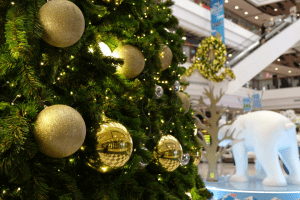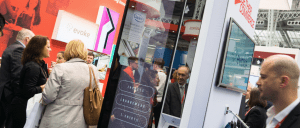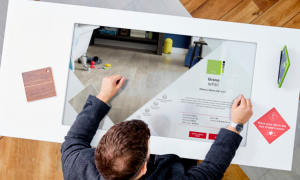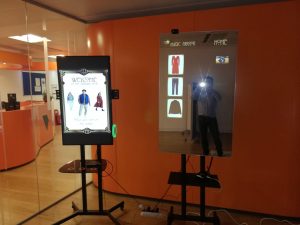5 Retail Technologies to Watch Out for This Christmas Season 2021
Even before recent events, the retail and leisure industry was a difficult environment, particularly for retailers in UK shopping centres and on the high street. The last few months have simply intensified these challenges.
The good news for the high street this Christmas is that online influence will wane slightly as one in three shoppers return to stores says Retail Week’s Christmas Forecast report. Online will remain the primary channel, with click and collect remaining as popular this year as last, but they expect spending in-store to recover from last year.

The research also shows consumers are indicating they will have more people to buy for this year and they are expecting people to spend more. While 61% are expecting to spend the same as last year, 24% are expecting to increase spending, with 22% of those wanting to make Christmas extra special. The four sectors that are set to bounce back this Christmas based on pent-up demand and a continuation of pandemic trends are health and beauty, fashion, toys and games, and furniture and flooring.
Springboard, a consultancy that measures footfall in retail destinations across the UK, is confident that shopping centres will experience an upturn in traffic this golden quarter because of the mix of leisure and shopping they provide.
These recent results should be positive for the high street: confidence is up, people have spare cash, and they are keen to spend.
In this article, we look at five of the biggest technology trends that we believe will make a huge impact on the retail industry this Christmas and beyond.
From click and collect kiosks to magic mirrors, in-store technology is rapidly changing the face of the retail industry, making this an exciting time for a sector that shows real signs of growth.
1. Kiosks
Kiosk technology allows users to touch the screen and see customisable content that can display information such as automated check-in, wayfinding, emergency notices, travel information click and collect services, browsing and ordering.
Replacing traditional manned collection desks that typically have queues during busy periods, means customers no longer have to wait to be served and can process their collections or returns straightaway using the self-serve digital screens. Using click and collect technology can also increase footfall and potentially make incremental sales and free up customer service teams for more complex enquiries.
Taking that a step further, integrated kiosk technology and digital signage can make the experience more interactive. E.g., whilst a customer is waiting for their order an on-screen video will appear specifically targeting products or services at that person. An integrated camera can recognise aspects of what that person is wearing and can promote chosen products to them. Once touched or no one is in front of the screen it will revert to the click and collect home page.
The interactive digital signage solution provides a seamless combination of form and function, providing an unattended self-service presence for multiple use cases in the retail industry.

2. Lift and Learn Digital Signage
Increasingly, shoppers are searching for a new and engaging digital experience when they enter a shop; and the Lift and Learn/Place and Learn technology is certainly one way to accomplish this. The technology is an interactive experience where the content on the screen changes whenever someone physically picks up a product. All the detail about the product is displayed clearly on the screen, instead of the customer having to pore over the small print on the packaging.
A unique RFID tag (a special electronic label) is attached to the base of each product involved in the experience. This allows the digital signage device to detect when a product is lifted from a pad or placed onto it, and these events can trigger changes in the content.
The interactivity and on-screen information help customers make an instant decision to purchase a product. One of the great features of using sensor technology is that retailers can track the interaction with any product so, every time someone is examining it or looking at it, they lift it up or place it on the pad you know that the product has had some interest in. The digital signage device can record the interactivity data and this information is available to the retailer.

Learn more about SignStix Lift & Learn/Place & Learn here.
3. Magic Mirrors
Another engaging digital experience when customers enter a shop could be the “Magic” Mirror. Magic mirrors are interactive kiosks that look, to the naked eye, like any other, regular mirror. However, once a shopper touches the glass, interactive digital content is displayed across the surface – making this tech trend a perfect fit for the retail industry.
Placed strategically throughout the physical retail store, magic mirrors will enable any customer to read reviews of products, check whether a particular product is in stock, browse an entire catalogue of items in a variety of shades and editions, or to even be inspired by a gallery of outfits achieved by other shoppers – the possibilities are endless.
However, for a truly next-level shopper experience, customers could even use the magic mirrors in-store to control the lighting around them, creating daytime and night-time environments as required.

Learn more about SignStix Magic Mirror Technology Here
4. Digital Shelf Edge
Although the concept of ‘electronic labels’ has been around for some time, advances in shelf-edge technology have seen digital shelf-edge capability and usages expand beyond simply displaying pricing. With modern shelf-edge displays, it’s easier than ever before for retailers to deliver promotional campaigns directly to product shelves and key merchandising areas. Digital shelf edges also enable retailers to influence in-store purchases with loyalty card incentives, online reviews, dynamic pricing and much more.
Furthermore, by updating shelf edge content in real-time, beauty brands can update prices quickly and are able to advertise special offers and incentives to customers in a new and exciting way.
For shoppers, this new technology can also aid their decision-making process, which will ultimately increase sales. The ability to include product reviews on the shelf edge will help to meet the demand that almost 50% of shopper’s place on retailers for other customers’ opinions, as well as utilising the best aspects of influencer marketing.

Learn more about SignStix Digital Shelf Edge Here
5. Contactless Payments
Over the past couple of years, we have been encouraged to use contactless payments where possible, rather than carrying cash.
Whilst this may not seem like a minor inconvenience to some, organisations such as charities miss out on the free change we may have previously carried in our pockets and donated. Britain is predicted to become a fully cashless society by 2026, meaning solutions like this will be around to stay.
One solution is to instead install a contactless way of donating to charities. Over the festive season, this can be presented as an eye-catching gift statue – a great way to encourage people to explore the new feature and boost donations.

Learn more about Contactless Payments here from our partner Conceptunet.
Intrigued about any of the technology in this article or have a project in mind and would like to contact us? Call our customer support dedicated helpline on 01135 313636 or email us at info@signstix.com.
https://www.conceptunet.com/digital-adaptations-to-the-covid-pandemic
https://www.retail-week.com/data/data-the-sectors-set-to-steal-christmas-2021/7040392.article
